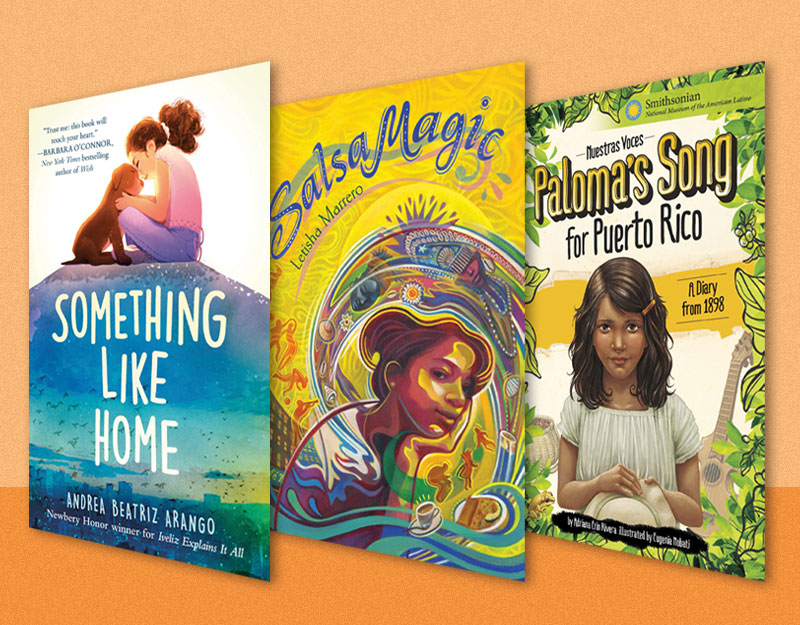3 Powerful Novels with Puerto Rican Protagonists | Middle Grade Spotlight
These moving middle grade novels center Puerto Rican girls navigating their relationships with their culture, their family, and themselves.

These moving middle grade novels center Puerto Rican girls navigating their relationships with their culture, their family, and themselves. Laura finds new hope in a stray pup while navigating the foster system in Arango’s Something Like Home; Maya unlocks fantastical family secrets in Marrero’s Salsa Magic; and a young girl reflects on the effects of U.S. rule on her homeland in Rivera’s Paloma’s Song for Puerto Rico.
 Arango, Andrea Beatriz. Something Like Home. 256p. Random. Sept. 2023. Tr $17.99. ISBN 9780593566183.
Arango, Andrea Beatriz. Something Like Home. 256p. Random. Sept. 2023. Tr $17.99. ISBN 9780593566183.
Gr 4 Up–Everything in Laura’s life is wrong, and it is all her fault. If she hadn’t called 911, then the police wouldn’t have found her parents on pills, and she wouldn’t have been sent to live with an aunt she doesn’t know while her parents are in rehab. Haunted by her guilt and lack of autonomy, Laura is struggling to find a place in a new school and in a house with rules she doesn’t understand when she discovers an abandoned puppy and sets out to train him as a therapy dog. Maybe he will be the key to visiting her parents so she can apologize and they can all go home together. Extraordinarily honest and sensitive, this novel in verse tactfully and gracefully deals with foster and kinship care and some of the many emotions involved. Laura and her aunt are both Puerto Rican, although Laura doesn’t speak fluent Spanish, and some simple Spanish phrases are included through their dialogue. The verse format and word choice make this a more accessible option than some other books on similar topics. Throughout the story, Laura learns to accept that her love for her parents does not make her responsible for their actions, and to allow herself to have space in her heart for all those who love and care for her. An author’s note supplies more information for readers who are not familiar with foster/kinship care, as well as encouragement to those who have experienced it firsthand. VERDICT So much affirmation, exploration, and positivity for those in similar situations are packed beautifully into these verses, making it a solid addition to collections.–Emily Beasley
 Marrero, Letisha. Salsa Magic. 288p. Levine Querido. Aug. 2023. Tr $18.99. ISBN 9781646142606.
Marrero, Letisha. Salsa Magic. 288p. Levine Querido. Aug. 2023. Tr $18.99. ISBN 9781646142606.
Gr 4-8–Maya Montenegro Calderon lives in Brooklyn with her large Puerto Rican family. At 13, she spends all her time at school, playing soccer, or helping out at the family restaurant, Cafe Taza. Recently, Maya has been plagued by curious dreams and questions that her family refuses to answer until she is older. Then her mysterious Titi Yaya arrives on the Cafe Taza doorstep, and Maya’s world is rocked and the strangeness in her life becomes even more frequent. In this novel steeped in family lore and West African Yoruba beliefs, Maya navigates old ideas and thirsts for new knowledge as she discovers how she fits into her vibrant family and the world beyond. It’s told through Maya’s first-person narrative; her stream of consciousness is endearing and relatable, and peppered with Spanish. Readers are transported to the streets of Brooklyn and treated to the sights, sounds, and smells of life in the restaurant. Characters are as diverse as the streets of New York; main family members are Puerto Rican, Afro Caribbean, and Mexican. VERDICT A must-buy for public and school libraries. Hand to readers who love magical realism and coming-of-age stories.–Maryjean Riou
Rivera, Adriana Erin. Paloma’s Song for Puerto Rico: A Diary from 1898. illus. by Eugenia Nobati. 112p. Capstone. Aug. 2023. Tr $26.65. ISBN 9781669012658; pap. $8.99. ISBN 9781669012610.
Gr 3-5–A young Puerto Rican girl witnesses her island’s transition from Spanish colony to U.S. territory in this richly detailed historical fiction novel. Twelve-year-old Paloma’s diary entries express the hopes and fears of her entire homeland as war for control of Puerto Rico reaches her coffee farm home. Will the new U.S. regime preserve native culture and offer self-rule? The answer comes in the novel’s final chapter, set 27 years ahead in 1925, as adult Paloma—now living in New York City—reflects on the fate of her family and the impact of U.S. rule. The Puerto Rico of Paloma’s youth is vividly realized, from the mango trees and chickens she tends to the colorful bustle of the marketplace where her family sells eggs and plantains. Spanish terms are woven throughout the narrative, a bit unevenly: some terms are defined as part of the narrative, some through grayscale spot art, some in the glossary. Additional back matter includes discussion questions and a QR code link to Smithsonian Museum resources on Puerto Rican history. Publisher notes indicate this is the first entry in a series depicting key moments in American history from a young Latinx character’s perspective. VERDICT Ideal as a classroom read-aloud and recommended for libraries seeking to expand their collection on Latinx history and culture.–Marybeth Kozikowski
RELATED
The job outlook in 2030: Librarians will be in demand
The job outlook in 2030: Librarians will be in demand
ALREADY A SUBSCRIBER? LOG IN
We are currently offering this content for free. Sign up now to activate your personal profile, where you can save articles for future viewing





Add Comment :-
Be the first reader to comment.
Comment Policy:
Comment should not be empty !!!